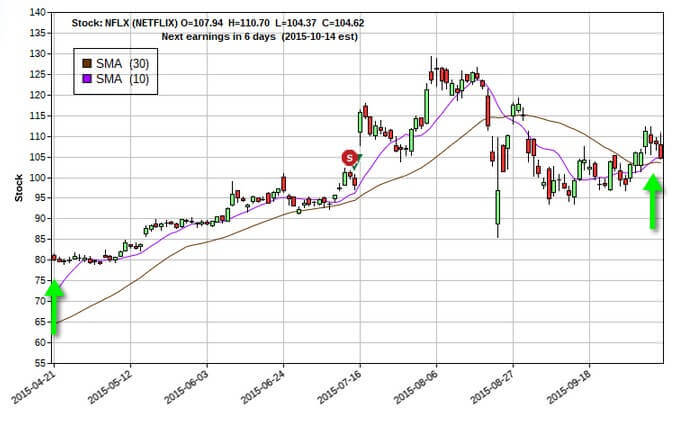Editor's Note: Last month we shared Tom's three-question quiz to help you find your trading type. Now it's time to tailor your trading approach to match your personality. Tom reveals which strategies best suit your goals and risk tolerance below. Take a look...
I recently gave you a quick quiz - three simple questions to help you determine what type of trader you are.
Many of us are directional traders, which means we assess the direction of the broader markets or individual securities and then trade accordingly, taking long positions we believe will go up in price and short positions on securities we believe will go down in price.
Now that you're armed with this very important piece of information, many of you have asked: What's next? What strategies do I use now that I know I'm - say - a medium-term rules-based directional trader (like me)?
Today, I'm going to show you a simple options trading strategy that allows you to target lucrative opportunities... and it relies on a tool we've talked about a lot in recent weeks: the simple moving average (SMA). So I hope you've been paying attention!
Let's get started...
Before I tell you about today's options trading strategy, I want to make sure you know what type of trader you are. If you followed along with my quiz, you should already have a firm grasp on what type of trader you are.
If you missed last week's article, or if you're still confused, figuring this out is as easy as answering these three questions:
- Are you a discretionary trader or a rules-based trader?
- Are you a directional or non-directional trader?
- Are you a short-term trader or a long-term trader?

Once you've got that down, you should at least have an idea of who you are as a trader (if you need help answering these questions, click here).
Now, what type of trader you are may change as you trade, gain more experience, and experiment with different trading strategies.
That's well and good, but you want strategies that you can use to profit right now.
So let me show you a directional options strategy you can put to use immediately. It will also help to highlight the difference between a rules-based trader and a discretionary trader, which will help further reinforce which type of trader you are.
The 10/30 SMA Crossover
Let's take a close look at a strategy called the 10/30 simple moving average (SMA) crossover. This is a directional trade that gives a trader the entry signal on a stock or the appropriate long option (call or put).
Note: If you're a non-directional trader (or want to test out different strategies before you decide which trading type suits you best), don't worry - I've got a terrific non-directional strategy that I'll tell you about very soon, so stay tuned.
Here's a quick rundown:[mmpazkzone name="in-story" network="9794" site="307044" id="137008" type="4"]

When the 10-day SMA crosses above the 30-day SMA, that is your cue to enter a bullish trade. In the chart for Netflix Inc. (Nasdaq: NFLX) above, you can see that the 10-day SMA crossed above the 30-day SMA. The green arrows indicate the crossover.

When the 10-day SMA crosses below the 30-day SMA, that is your cue to enter a bearish trade. Again, take a look at the chart above, this time for Apple Inc. (Nasdaq: AAPL). The red arrows indicate the crossover.
With this strategy, you set your stop to trigger when the 10-day SMA reverses and crosses back over the 30-day SMA. For example, if you entered a bullish trade when the 10-day crossed above the 30-day, then you would stop out when the 10-day later crosses below the 30-day SMA.
The Rules-Based Trader's Approach
A rules-based trader has a specific set of criteria that MUST be met in order to participate in a trade. For the 10/30 SMA crossover, the rules-based trader sets in place these strict criteria:
- The stock must be $50 or higher.
- The 10- and 30-day SMA must be higher than the 200-day SMA.
- The stock must also be above the 200-day SMA.
- The stock must trade at least 1 million shares on average per day.
If all of these items are not met, the rules-based trader passes on the trade and moves on to the next opportunity.
The Discretionary Trader's Approach
The same basic idea is in place here. The 10-day SMA must cross the 30-day SMA, but the entry criteria are more subjective in that the discretionary trader allows some wiggle room as to which criteria must be met.
- The stock must be $50 or higher.
- The 10- and 30-day can be above or below the 200-day SMA.
- The stock can be above or below the 200-day SMA.
- The stock must be trading on above-average volume.
As you can see, a discretionary trader still has a set of rules in place, but they aren't bound to them the way a rules-based trader is. The rules aren't so strict that trades are passed over if one of the above criteria is not met.
A Note about Your Trading Timeframe
Being a rules-based or discretionary trader has some bearing on the type of trading strategy you use, but how long you plan on being in your trades impacts your trading strategy even more.
Now the question is this: Are you a short-term, medium-term, or long-term trader?
For our purposes:
- Short term: Roughly seven to 10 days in length
- Medium term: From seven to 30 days
- Long term: Two months or longer
The 10/30 SMA crossover is a short- to medium-term trading strategy.
You have seen trades from me using both the Money Calendar and DarkNet. These are trading tools that I use to find medium-term trade opportunities. The back testing that has been done on these tools shows that the stocks they find make their price moves within 20 to 30 days.
But I have also used case studies from Money Calendar to show you how trades can work out in as little as one to three days, when the markets turn an expected medium-term trade into a short-term trade.
That's perfectly OK! In fact, it's great because it means we can make more efficient use of our capital by putting it into our next opportunity.
The thing you do not want to happen is for a short-term or medium-term trade to turn into a long-term trade. There is a trader's adage that speaks to this: You know what an investment is to a day trader? Answer: A day trade gone bad.
The longer you trade, the better you'll know your trading type. The key to success is repeating and duplicating a successful process. Determining the type of trader you are and knowing which strategy to employ will go a long way.
If You Like Fast Cash, You Don't Want to Miss This
I love fast money. That's why I've been working on a new invention. It's a way to get rapid-fire profits in your hands week after week.
I'm talking about trades you can make from anywhere, even right on your phone, in four days or less.
The pattern behind these quick paydays appears every single week. And I'm the only one who knows how to find it.
I've used it to show my readers top gains like 100% on RTN in one day, 100% on BIDU in one day, 120.93% on MS in two days, and 124% on ABBV in one day.
If you hope to find yourself with a pile of extra cash in your pockets, click here to learn more...
Tom Gentile is America's No. 1 Pattern Trader, and for good reason. Since 2009, he's taught over 300,000 traders his option trading secrets, including how to find low-risk, high-reward opportunities. Now he's sharing that insight with you. To get started, just click here - you'll get Tom's twice-weekly Power Profit Trades delivered directly to your inbox, free of charge.
About the Author
Tom Gentile, options trading specialist for Money Map Press, is widely known as America's No. 1 Pattern Trader thanks to his nearly 30 years of experience spotting lucrative patterns in options trading. Tom has taught over 300,000 traders his option trading secrets in a variety of settings, including seminars and workshops. He's also a bestselling author of eight books and training courses.



